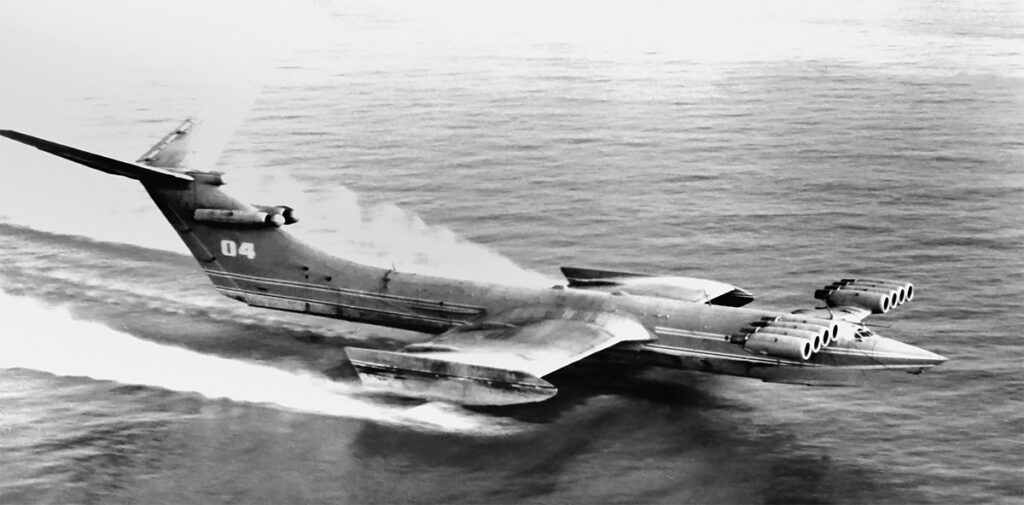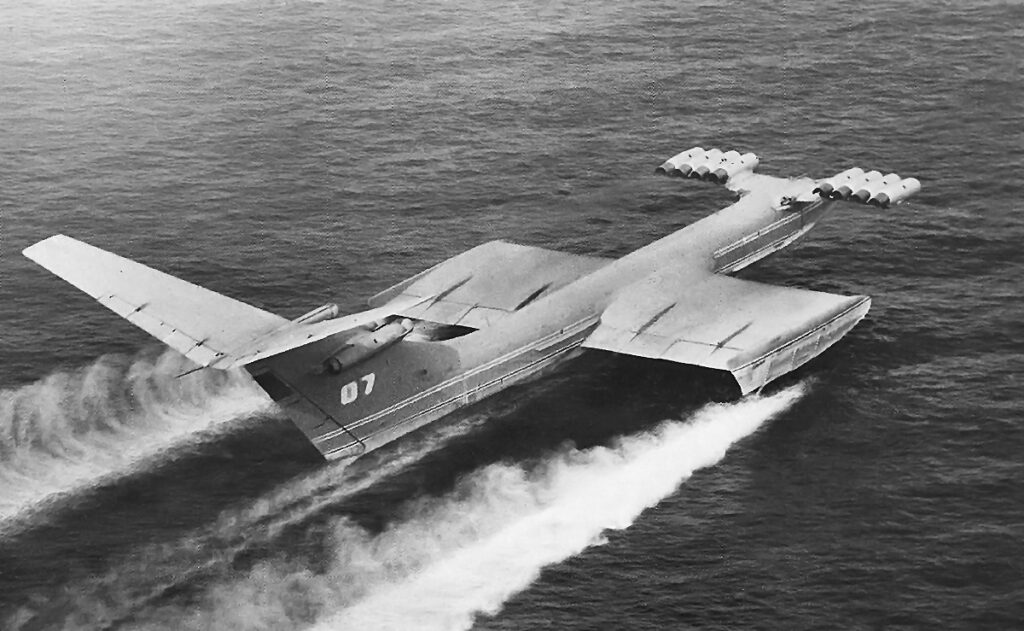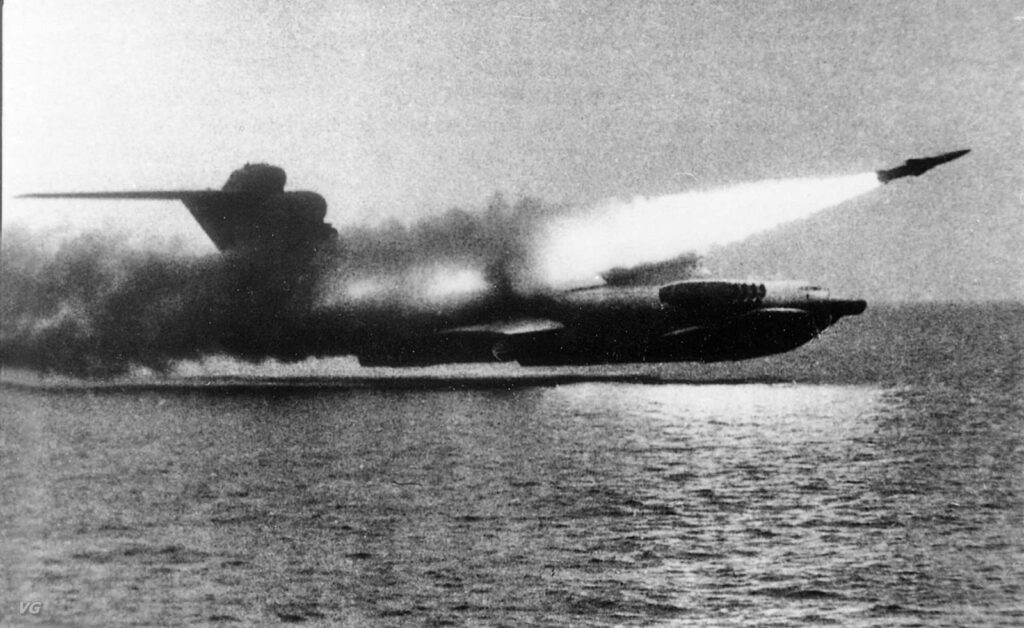The Lun-class Ekranoplan is a unique and fascinating machine that straddled the line between resembling an aircraft and a ship.
Developed in secret in the Soviet Union from the 1980s onwards, it was an example of a ground effect vehicle that uses an aerodynamic phenomenon known as “ground effect” to achieve high speeds while flying just above the water’s surface.
It was perhaps an example of the extraordinary lengths both sides of the Cold War went to in developing new weapons and technology to outmatch each other.
Origins
The origins of the Lun-class began with the concept of the Ekranoplan itself. In the 1960s, the Soviets began to experiment with a new design they termed the KM (or the Model Ship).
The Soviet government had become interested in the idea of experimenting with the concept of a ground effect vehicle (GEV).
The idea was that a GEV could function like a plane but exploit what is known as “ground effect” to glide a few meters rather than several thousand feet above the earth, generally over water.
The Soviets believed that a GEV would be capable of moving at a fast speed and avoiding radar detection due to a combination of stealth design qualities and keeping low to the water.
The Russian Central Hydrofoil Design Bureau was tasked by the Soviet government with creating the new design and engineer Rostislav Alexeyev was appointed as its chief designer. Development on the new GEV craft began in 1964.
 The KM Ekranoplan, better known as the Caspian Sea Monster.
The KM Ekranoplan, better known as the Caspian Sea Monster.
The KM’s philosophy was based on science that showed when aircraft are within a certain distance of the ground, they will experience reduced drag thanks to the airflow around the plane interacting with the ground beneath.
This produces additional lift and allows an Ekranoplan to be built with small wings, provided that the plane stays relatively close to the earth.
A large body of water such as the Caspian Sea provided an ideal location to test the theory.
The KM was completed in 1966, and at the time was the largest aircraft in the world totalling at 100 feet in length, although the Soviets themselves considered it closer to a boat due to its lack of wings and its water-borne design.
The Soviet government subsequently assigned control and maintenance of the KM to the Russian navy over the air force.
In June 1966, the KM was towed down the Volga River to begin its first testing trials on the Caspian Sea, a place the Soviets felt had the right conditions to monitor its water and air capabilities.
 Rear view of the Caspian Sea Monster, gliding just above the surface of the water. It weighed over 550 tons.
Rear view of the Caspian Sea Monster, gliding just above the surface of the water. It weighed over 550 tons.
In 1967, a CIA spy satellite captured an image of the finished Ekranoplan in a dock.
The American government were mystified by the image they saw of what looked like a giant plane that apparently had no wings and yet was still capable of flight.
It was nicknamed the “Caspian Sea Monster”, which stuck for subsequent Soviet made Ekranoplan designs.
The Soviets continued to test the KM for various roles until it crashed into the water during a trial run in 1980.
No lives were lost in the accident, but the KM was written off and the Soviets decided it was too heavy and damaged to try salvaging.
It remained floating on the water before sinking to the bottom of the Caspian a week later.
Project 903
Despite the setback, the Soviets were undeterred and used the KM as a basis to create a new Ekranoplan.
Drawing on lessons learned from the KM, the Soviets termed their new design as Project 903.
The new creation was designed as a smaller Ekranoplan and would be powered by eight Kuznetsov NK-87 turbofan engines which provided a total thrust of 62,000 pounds.
It was also built with a hull similar to that of a flying boat to give it better streamlining and water landing capabilities.
 MD-160 Lun-class Ekranoplan. Note the missile launcher tubes running down its back.
MD-160 Lun-class Ekranoplan. Note the missile launcher tubes running down its back.Project 903 became known as the “Lun” (Russian for harrier) Ekranoplan.
Although smaller than the KM, the Lun-class was still a huge machine.
It measured at 240 feet in length and 62 feet in height. It has a wingspan of 144 feet and had the capability of reaching up to 340 miles per hour.
It was also designed to be highly manoeuvrable, with a turning radius of 1,476 feet.
It could also take off and land on water, making it ideal for use in coastal areas and for transporting men or goods quickly across a lake or short expanse of sea.
The Monster takes to the seas
The first Lun class design was intended for surface to air combat. Six missile and rocket launchers were mounted on the fuselage and designed to carry the P-270 Moskit guided missile.
Construction was finished in 1987 and it was put into service in 1989 with the number MD-160.
As intended, it served with the Soviet navy to patrol up and down the Caspian Sea as part of the navy’s “Caspian Flotilla” division.
In the West, the MD-160 was given the NATO codename “Duck” and continued to be regarded as an unusual yet fascinating machine by Eastern and Western aviation observers.
 Lun-class Ekranoplan travelling at high speeds. Note the distance between it and the water surface.
Lun-class Ekranoplan travelling at high speeds. Note the distance between it and the water surface.
Despite the innovative ideas behind the Ekranoplan, the Lun-class was found to have some drawbacks during its service.
Its crews noted that although the ground effect enabled it to fly at low altitude below radar, its short wingspan meant it could not fly higher than 5–10 ft off the water or it would risk potentially losing control and crashing downward.
As a result, the Lun could only be used when the Caspian Sea was smooth and in rough weather it had to be put into storage at shore.
As well as risky to pilot on choppy seas, the second weakness was that the Lun class was only designed to move using only the ground effect principle and could not take full flight like a conventional plane, even with its powerful engines.
The requirement for good weather conditions for use and its inability to fly higher above rough weather conditions severely limited the times of year and the location of where the Lun was able to successfully operate.
 MD-160 firing a Moskit missile while in ground effect.
MD-160 firing a Moskit missile while in ground effect.
A second Lun-class Ekranoplan was proposed as a search and rescue craft by the Soviet Ministry of Defense.
Construction began in the late 1980s and it was given the name “Spasatel” (meaning rescuer) to reflect its intended role before the Soviet authorities decided that the second Lun would become a floating field hospital.
A majority of the Spasatel’s airframe was completed by the late 1980s, but the project was suddenly put on hold and then halted altogether in 1991 following the collapse of the Soviet Union.
The end of the Cold War prompted both sides to somewhat reduce their military inventories and the haphazard state of the Russian economy meant that money could not be allocated for vast and expensive projects.
The almost completed Spasatel was towed to an industrial port on the Volga River where it remains to this day.
Talks in both government and private circles have periodically arisen on whether to finish the Spasatel but so far no plans have come to fruition.
Aftermath
The completed Lun-class Ekranoplan was withdrawn from service in the 1990s, having never been used in a direct combat situation.
It was towed to a naval station in Kaspiysk, Russia, stripped of some its important components and left unused.
Over time, the mothballed Ekranoplan began to rust due to constant exposure to changing weather conditions despite calls for its preservation.
In 2020, the dormant Lun-class Ekranoplan was earmarked for restoration and a flotilla of three tugs and two navy escort vessels with floating pontoons were assembled to move the MD-160 to a new home.
 Lun-class Ekranoplan beached in 2021, on the edge of the Caspian Sea.
Lun-class Ekranoplan beached in 2021, on the edge of the Caspian Sea.
The intention was to move the Ekranoplan to Derbent as part of a display for the proposed “Patriot Park” – an open air museum designed to showcase Soviet and Russian military equipment.
During the towing, the MD-160 was accidentally beached before reaching Derbent and remained stuck in the sand despite repeated attempts to free it.
The onset of the COVID-19 pandemic also disrupted plans to keep moving it to the museum.
 The beached machine gives a good sense of its immense size.
The beached machine gives a good sense of its immense size.
Although it did not initially reach the Patriot Park destination, the beached Ekranoplan became a magnet for tourists, aviation enthusiasts and urban explorers who were fascinated by the giant machine stuck on the beach and wanted to have the chance to see the notorious Caspian Sea Monster up close.
Unfortunately, the MD-160 was also more exposed to the waves and storms as it had been in Kaspiysk, with reports indicating that it was taking on water.
In December, 2020 the Ekranoplan was successfully dislodged despite taking water into its tail and was towed out nose-first to resume its journey. It currently sits on dry land in anticipation for public display.
Legacy
Despite not seeing active service, the Lun-class Ekranoplan was a remarkable machine that signified a unique chapter in the history of aviation.
It was designed and built during a time of intense military competition between the Soviet Union and the United States, and the science and capabilities behind making it work were nothing short of astonishing.
Although the concept of the ground effect vehicle somewhat fell out of favour following the Lun-class’ decommissioning and its service exposed some flaws in the concept, its legacy has continued to intrigue current generations of engineers and aviation enthusiasts.
Design engineers in Singapore, the United States, China and Russia have since worked on different projects and prototypes based the ground effect vehicle principle that have the potential to bring Ekranoplans back to life, albeit for civilian over military purposes.





